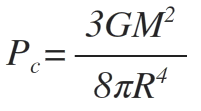Liquid Planet!
Consider a spherical planet with radius made of a liquid with density . Find the pressure in the center of the planet, in N/m .
Details and assumptions
- kg/m
- N m /kg
- m
The answer is 5.2E+4.
This section requires Javascript.
You are seeing this because something didn't load right. We suggest you, (a) try
refreshing the page, (b) enabling javascript if it is disabled on your browser and,
finally, (c)
loading the
non-javascript version of this page
. We're sorry about the hassle.


First, let's determine the gravitational find at a generic distance r from the center.
"Gauss's Law" for gravitation
∫ g ⋅ d A = 4 π G M e n c l o s e d
Consider a concentric sphere with the planet (radius r, r<R) as our gaussian surface. "g" will be a constant along our integral, so itleaves the integral and we are left with an area integral(the surface area of the inner sphere).Then:
g 4 π r ² = 4 π G M R ³ r ³ g = G M R ³ r
Now that we have g, let's try to adapt P = ρ g h for this variable g situation. Consider a tiny column of liquid, with height dh exerting a pressure dP
d P = ρ g d h = ρ g d r
Pluggin the g we found and integrating both sides, we get: d P = ρ G M R ³ r d r P = R ³ ρ G M ∫ 0 R r d r = 2 R ρ G M Doing the math, P = 5 . 2 E 4